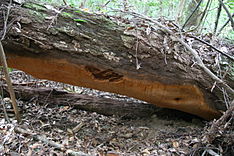Phellinus ellipsoideus
| Phellinus ellipsoideus | |
|---|---|
 |
|
| The large fruit body discovered in 2010 | |
| Scientific classification | |
| Kingdom: | Fungi |
| Division: | Basidiomycota |
| Class: | Agaricomycetes |
| Order: | Hymenochaetales |
| Family: | Hymenochaetaceae |
| Genus: | Phellinus |
| Species: | P. ellipsoideus |
| Binomial name | |
|
Phellinus ellipsoideus (B.K.Cui & Y.C.Dai) B.K.Cui, Y.C.Dai & Decock (2013) |
|
| Synonyms | |
|
|
| Phellinus ellipsoideus | |
|---|---|
| Mycological characteristics | |
| pores on hymenium | |
| no distinct cap | |
| hymenium attachment is not applicable | |
| lacks a stipe | |
| ecology is saprotrophic | |
Phellinus ellipsoideus (formerly Fomitiporia ellipsoidea) is a species of polypore fungus in the family Hymenochaetaceae, a specimen of which produced the largest fungal fruit body ever recorded. Found in China, the fruit bodies produced by the species are brown, woody basidiocarps that grow on dead wood, where the fungus feeds as a saprotroph. The basidiocarps are perennial, allowing them to grow very large under favourable circumstances. They are resupinate, measuring 30 centimetres (12 in) or more in length, though typically extending less than a centimetre from the surface of the wood. P. ellipsoideus produces distinct ellipsoidal spores, after which it is named, and unusual setae. These two features allow it to be readily differentiated microscopically from other, similar species. Chemical compounds isolated from the species include several steroidal compounds. These may have pharmacological applications, but further research is needed.
The species was named in 2008 by Bao-Kai Cui and Yu-Cheng Dai based on collections made in Fujian Province. It was placed in the genus Fomitiporia, but later analysis suggests that it is more closely related to Phellinus species. It was revealed in 2011 that a very large fruit body, measuring up to 1,085 cm (427 in) in length, had been found on Hainan Island. The specimen, which was 20 years old, was estimated to weigh between 400 and 500 kilograms (880 and 1,100 lb). This was markedly larger than the previously largest recorded fungal fruit body, a specimen of Rigidoporus ulmarius found in the United Kingdom that had a circumference of 425 cm (167 in). The findings were formally published in September 2011, but attracted international attention from the mainstream press prior to this.
...
Wikipedia
